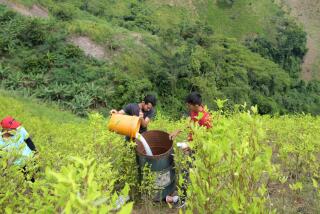Market Focus : Huge Petroleum Field Leaves Few Gushing : * Property disputes and Colombian guerrillas are dampening enthusiasm for one of the largest recent oil finds in the Americas.
- Share via
BOGOTA — Analysts are calling it one of the largest oil finds in the Americas in the last quarter-century, but the discovery of the so-called Cusiana field in northeastern Colombia has produced a notably muted reaction from the Colombian government and three foreign petroleum firms developing the area.
Dampening their celebration of billions of barrels in new oil reserves are two other groups demanding part of the take.
A dozen Colombian families claiming title to the oil-rich area about 100 miles east of the capital have mounted a legal challenge that could deny the government billions of dollars of petro-profits.
Another campaign against the state will be fought, not in the courts, but in Cusiana’s jungles, where analysts say the oil industry will make a tempting target for leftist rebels belonging to the National Liberation Army, or ELN.
“I expect Cusiana will result in a period of important growth of Colombia’s oil industry followed by more frustration,” said one Bogota executive, referring to Colombia’s long struggle to overcome the insecurity keeping away many foreign petroleum investors.
He and other analysts agree, however, that such problems seem lessened by the sheer size of Cusiana. Exactly how much oil lies under the area in Casanare state is still unclear, but estimates of potential reserves range from 3 billion to 5 billion barrels. Analysts say such reserves would lift the country’s exports to 500,000 barrels per day from the current 200,000 and increase its earnings to about $2.5 billion a year by 1995.
Colombia is Latin America’s third largest petroleum exporter behind Mexico and Venezuela. The country produces nearly 440,000 barrels of oil a day from proven reserves of 1.9 billion barrels.
“I am convinced that (Cusiana) is a world-class find, but there are a lot of questions about the area still unanswered,” said Andres Restrepo, president of the state-run oil company Ecopetrol, in an interview.
One of those unanswered questions is just how much of Cusiana’s profits Ecopetrol and other state entities will receive. Though Colombian law allots 80% of the profits of any large oil find to the government, the share could be reduced if private claimants of land in the Cusiana region finally win a dispute nearly 70 years old.
The administration of President Cesar Gaviria wants to reverse a 20-year-old decree awarding a significant chunk of Cusiana land to the descendants of a black army general who reclaimed the territory on the government’s behalf in the 1920s. A final resolution of the conflict by a state tribunal is expected later this year.
“The government is threatening to expropriate our land if it loses in court,” said one of the 56 people, from 12 families, who claim rights to 4% of Cusiana’s oil earnings. “This is just a case of a greedy state ignoring the right to private property.”
He added that the government could hurt its long-term interests if it resorts to expropriation. “How are foreign investors suppose to be secure here if the government guarantees them certain profits one day and then takes them away the next?”
At Ecopetrol, Restrepo contends that the government can make a strong legal case that the families “should never have been given the land in the first place.”
The clashing positions have so hardened since the first well was drilled in Cusiana three years ago that most petroleum analysts believe a negotiated settlement to the conflict is out of the question.
“There is too much envy to solve the dispute reasonably,” said the owner of a drilling equipment firm. “This is a country where more people die of envy than of heart attacks.”
The sums involved would likely turn hearts green in any country. If granted, the 12 families’ claim to 4% of Cusiana’s profits could earn them close to $50 million a year at current oil prices, easily placing them among the richest individuals in Colombia. By comparison, three foreign oil companies helping to develop Cusiana stand to make about $620 million a year. Ecopetrol’s contract with British Petroleum Co., U.S.-based Triton Energy Corp. and TOTAL-Compagnie Francaise des Petroles of France guarantees the three foreign partners the same share no matter what the courts decide in the land dispute.
The firms do, however, share another of Ecopetrol’s enemies. The ELN guerrillas have targeted both public and private oil companies in what the rebels call a campaign to force the nationalization of Colombia’s oil industry.
In November, the ELN reportedly received a hefty ransom for three engineers from the Oklahoma-based Natco Co. after holding them hostage for a year. Two Japanese and three French engineers were also kidnaped in 1991.
Rebels reduced the 1991 national oil output by 2% with 61 dynamite attacks against the main oil pipeline running from the eastern Cano Limon fields, previously Colombia’s richest, to the Caribbean coast, Ecopetrol reported last week. Since they began in 1986, pipeline bombings have spilled some 35 million gallons of crude oil--roughly three times that released in the Exxon Valdez disaster in Alaska.
Ecopetrol estimates that the attacks have cost the national economy $700 million in the last six years.
“Unfortunately the guerrillas are very mobile and can move into Cusiana tomorrow,” said Restrepo.
Government peace talks with the ELN and another rebel group, the Revolutionary Armed Forces of Colombia, have bogged down in Caracas, Venezuela, over the terms of a cease-fire. A senior Colombian official said Cusiana’s wealth will make it harder for the government to negotiate with the ELN. “As long as they have a way to finance their activities, there will be a tendency to keep fighting,” he said.
Despite the continued threat, British Petroleum Co., which leads the foreign consortium, said last week that it expects to spend $200 million and to have 10 oil rigs operating in the Cusiana area this year.
Oil in Latin America Latin America has more than four times the proven oil reserves of the United States, but daily production is about the same. The Middle East far outproduces both.
In millions of barrels Venezuela: 59,100 Mexico: 51,298 Brazil: 2,800 Colombia: 1,935* Argentina: 1,570 Ecuador: 1,550 Peru: 382 Chile: 300 Bolivia: 119 Cuba: 100 Guatemala: 35 In thousands of barrels per day Venezuela: 2,341.3 Mexico: 2,777.0 Brazil: 635.8 Colombia: 439.2* Argentina: 487.3 Ecuador: 292.6 Peru: 116.2 Chile: 17.8 Bolivia: 22.3 Cuba: 15.0 Guatemala: 3.8 Total Latin America: 119,189 United States: 26,250 Soviet Union: 57,000 Saudi Arabia: 257,842 Total Middle East: 661,571 Total World: 991,011
ESTIMATED 1991 PRODUCTION Total Latin America: 7,148.3 United States: 7,371.4 Soviet Union: 10,260.0 Saudi Arabia: 8,157.7 Total Middle East: 16,248.5 Total World: 59,919.5 * Does not include unconfirmed reserves in new Cusiana field.
Source: Oil & Gas Journal.Reserves figures are as of Jan. 1.
More to Read
Sign up for Essential California
The most important California stories and recommendations in your inbox every morning.
You may occasionally receive promotional content from the Los Angeles Times.










